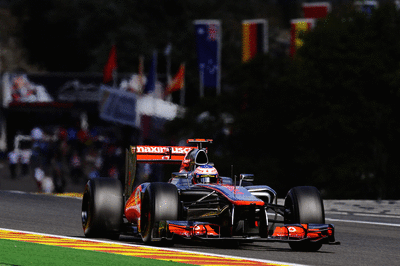The idea behind these type of Flexi Wings was that the outer section of the wing would droop to the floor when under load. This helped to navigate the airflow inbound rather than losing some of the flow laterally around the outside of the wheel.
McLaren were one of the teams that failed to assimilate the Red Bull's design in full but have since then been running with a Front Wing that does flex just in a different way. The McLaren Front Wing flexes under load but when doing so the whole outer portion of the wing tilts backwards. The reason for this is that as downforce exponentially increases with speed so does drag. By having the wing planes / cascades tilt backward at a speed threshold you reduce both downforce and drag allowing the car to attain a top speed easier. Design of the whole region with this in mind will also allow for more airflow to be sent inbound which is crucial this year without EBD.
Red Bull's new Front Wing in Singapore is reportedly designed with the same 'lean back' style aero advantage that McLaren have been utilising for some time which has lead to Ferrari requesting the FIA look into their designs.
Although I don't see these Wings being outlawed in Suzuka the FIA may adjust the load tests in forthcoming races in order to reduce their affect. But as with the original Flexi Wings it will more than likely entail a re design of the Front Wing Pylons too.
(EDIT - Before Suzuka, a 1000N (approximately 102kg) load test was applied to an area of the front wing 790 mm forward of the front wheel centreline, and 790mm from the car centre line. The wings are allowed to deflect just 10mm. For Suzuka the FIA has tweaked this and is now testing the area 675mm forward of the front wheel centreline) All Front Wings passed the new FIA tests but it's not known if any of the teams made adjustments beforehand as they knew the tests could be altered.
Front Wings are crucial in the flow structure this season due to their effect downstream with EBD banned it's vital to get airflow moving toward the rear of the floor. This is why we have seen teams using the FOM TV camera's in a position between the Front Wings pylons behind the central portion of the wing that is mandated. This positioning helps to affect an area of airflow that normally can't be affected.
Above: In this image from Spa we can see that the Front Wing on Jenson's car is leaning back under load

In the image above I've rotated the Endplate in order to show you how this rotation may appear (obviously the effect is much more graduated under load / speed and the whole wing section will rotate but I can't show this easily)

.png)
 By
By  Wednesday, October 03, 2012
Wednesday, October 03, 2012







Haven't we seen similar stuff last year at Europa GP?
ReplyDeleteI have cited the post at F1Technical, too.
Indeed Kiril, I'm not sure what all the hoo-har is about but AMuS have run the story so I thought I'd follow up with a post on the subject.
ReplyDelete